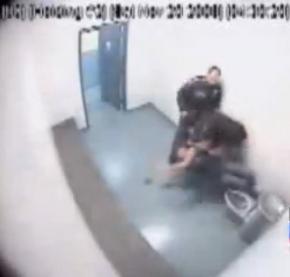A cop’s attack caught on video
A King County sheriff's deputy's beating of a 15-year-old girl, captured on video, is only the latest example of the brutality of Seattle-area police, writes .
THE SEATTLE area got a disturbing look at what goes on behind closed doors at the King County Sheriff's Department when a video was released to the media in late February, showing a sheriff's deputy assaulting a 15-year-old girl in a holding cell.
Malika Calhoun was picked up on November 29 for driving her parents' car, which had been reported stolen. Officers claimed that she was "real lippy" after being informed she was under arrest, and called them "fat pigs." As they escorted her to a holding cell in the SeaTac City Hall, Deputy Paul Schene asked her to remove her shoes, at which point she removed one and kicked it toward him.
Schene then lunged through the door and kicked her, striking either her stomach or upper thigh area. He pushed her against a corner wall before flinging her to the floor by her hair. He then squatted down on her and delivered two blows on what appears to be her head. At this point, Malika was limp, and the officer is shown dragging her off the ground and out of the cell by her hair.

Schene, an eight-year veteran of the sheriff's office, filed a report about the incident claiming that an injury to his shin was caused by Malika kicking off her shoe at him, but the video shows his shin apparently striking a metal toilet as he throws her into the corner of the cell.
Schene pleaded not guilty to misdemeanor assault in King County District Court in November and remains on paid administrative leave pending a full investigation. He is the third sheriff's deputy since 2006 to face allegations of excessive force--and all three are from the same precinct, which covers SeaTac, Burien and the White Center and Skyway areas of King County.
This isn't the first such incident of Schene's career. In 2006, he fatally shot Pedro Jo, a mentally ill man, during a struggle after a traffic stop on Interstate 5. A jury ruled that the shooting was justified because Jo had attacked Schene and tried to strangle him with his own radio cord, but Schene didn't fire until Jo was running to his car. Jo was shot 11 times in the back. Shortly after the shooting, while he was on paid administrative leave, Schene was stopped for driving under the influence.
On the heels of the outrage over Malika's beating, local law enforcement was faced with yet another scandal. Yolanda Bell contacted a lawyer with the NAACP after she discovered her teenage son's photo in a Seattle Post-Intelligencer article titled "Officers patrol Seattle's deadly gang problem."
Yolanda's son and three friends were waiting outside a movie theater on February 7 for a grandfather to pick them up when police showed up with a cameraman. As an article on the incident in Real Change recounts, the harassment of the innocent teens was clearly staged for the sake of a photo op:
Come over here, the man told two of the boys. He got out of the car. What's your street name? he asked one, who had none. What, he giggled, you don't have any street cred?
He asked about their haircuts: What do they mean? And the color of their clothing: Why are you wearing so much gray? Two men with cameras got out of the backseat. They snapped pictures while the officer, the kids recalled later, began to pose.
THESE INSTANCES are the latest in a long history of harassment and racial profiling committed by Seattle-area law enforcement, typically without repercussions for the officers involved. The same newspaper that glamorized police profiling published an investigation just last year, which found that the Seattle Police Department takes disciplinary action only in about 1 percent of cases where a complaint of unnecessary force is made. Another article in the same series reported that African Americans in Seattle are arrested for the crime of obstructing an officer eight times as often as whites.
Despite this history, President Barack Obama's choice of Seattle Police Chief Gil Kerlikowske as "drug czar" at the Office of National Drug Control Policy is being touted as a move toward reform. The Obama administration promoted Kerlikowske as part of a new plan to emphasize treatment over jailing in drug-related cases.
It is true that Seattle made some positive steps in this direction. In 2003, Seattle voters approved an initiative directing law enforcement to treat personal marijuana possession as its lowest priority.
Since then, the overall number of drug cases in the city has dropped--but, disturbingly, only for white people. According to a report by the Marijuana Policy Review Panel, between 2003 and 2006 the portion of African American men among marijuana suspects grew from 52 percent to 57 percent--this in a city that is only 8 percent Black.
Another example of why Seattle is hardly charting a different course in the "war on drugs" is the city's plan to construct a new municipal jail, which current figures suggest will be filled primarily with people arrested for drug-related charges. At the same time, Washington state is considering cutting half of all beds in drug treatment facilities.
Thankfully, activists in Seattle are uniting to oppose construction of the new jail. Seattle can and should set an example for a more humane law enforcement policy. But Kerlikowske's police force clearly does not fit the bill.


